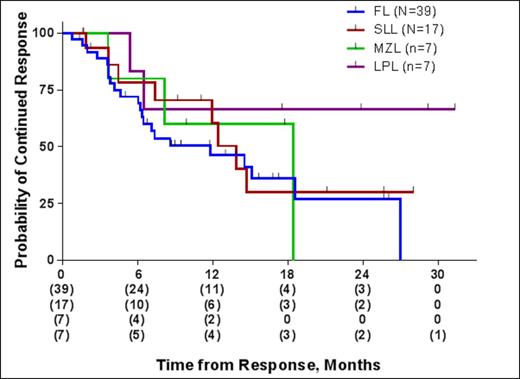Abstract
Introduction: Rituximab-alkylator combinations are the standard therapies for patients (pts) with iNHL, however, refractory disease nearly uniformly develops. Once iNHL becomes double-refractory to both rituximab + alkylating agents, there are limited options to induce durable remissions. PI3K-delta signaling is critical for activation, proliferation and survival of B cells, and is hyperactive in many B-cell malignancies. Idelalisib, a selective oral inhibitor of PI3Kd, demonstrated considerable clinical activity in double-refractory iNHL (Gopal NEJM 2014). FDA granted accelerated approval for Idelalisib (Zydelig®) in patients who have received at least two prior systemic therapies with relapsed FL or SLL. Based on these encouraging initial results, we now describe long-term follow up, safety, and remission durations of this double-refractory iNHL population treated with idelalisib.
Methods: Eligible iNHL pts included those with measurable disease refractory to both rituximab and an alkylating agent. Refractory was defined as lack of response to, or progression of lymphoma within 6 months of completion of index therapy, confirmed by imaging. Idelalisib 150 mg PO BID was administered continuously until disease progression or intolerance. Responses were evaluated by an independent review committee, using standard criteria (Cheson, 2007, and Owen 2013). The new data cutoff date for this analysis was June 2014, 20 months after the last patient enrolled.
Results: Enrolled pts (N = 125) had a median age of 64 years and included follicular lymphoma (FL) n=72 (58%), small lymphocytic lymphoma (SLL) n=28 (22%), marginal zone lymphoma (MZL) n=15 (12%) and lymphoplasmacytic lymphoma (LPL)/Waldenstrom's macroglobulinemia (WM) n=10 (8%). The median number of prior therapies was 4 [range 2-12], including bendamustine/rituximab (BR) (n=60) and rituximab, cyclophosphamide, doxorubicin, vincristine, prednisone (R-CHOP) (n=56) and autologous transplant (n=14). 81 pts (65%) had prior bendamustine, of which 61/81 (75%) were refractory. 112 pts (90%) were refractory to their last regimen, and 99 pts (79%) were refractory to ≥2 regimens. 38 pts (30%) had elevated LDH, and 33 pts (26%) had bulky disease >7 cm. The median time to progression from last prior therapy was 3.9 months.
With a median exposure of 11.1 months (range 0.7 to 35.4), the overall response rate (ORR) is 56% (95% CI = 46.8-64.9) with 70 responders, comprising 12 CRs (9.6%), 58 PRs (46.4%). The median time to response was 1.9 months (time of first evaluation) and time to CR was 4.5 months. There were 43 pts with stable disease (SD) (34.4%). 90% of pts experienced some decrease in tumor burden.
ORR for iNHL subtypes is: FL (54%), SLL (61%), MZL (47%), and LPL/WM (70%). CR rate for iNHL subtypes is: FL (14%), SLL (4%), MZL (7%), and LPL/WM (0%). Among responders, median DOR is 13.9 (0.03-31.3) months. DOR for iNHL subtypes in months (Figure 1) is: FL 11.8, SLL 13.9, MZL 18.4, and LPL/WM (not yet reached). Median PFS for all pts is 11.0 months, in comparison to a median PFS of the last prior regimen of 3.9 months (p<.0001). The median PFS for individual subtypes in months was: FL 11.0, SLL11.1, MZL 6.6, and LPL/WM 22.2. The median overall survival of all patients was 30.8 months.
The adverse events include (total%/≥ grade 3%) diarrhea/colitis (50/18), fatigue (30/2), nausea (31/2), cough (32/0), pyrexia (30/2), dyspnea (18/5), rash (14/2), pneumonia (14/11), and pneumonitis (4/3). Based on central laboratory measurements, Grade ≥3 ALT/AST elevations occurred in 18 pts (14%). Drug was temporarily held in these pts, and 11/15 pts (73%) were re-treated without recurrence of ALT/AST elevation. Overall, 30 pts (24%) have discontinued therapy due to adverse events.
Conclusions: The prolonged administration of idelalisib was well tolerated, had an acceptable safety profile, and was highly effective in inducing and maintaining remissions in double-refractory iNHL population with an ORR of 56%, PFS of 11 months, and DOR of 13.9 months. The response rate and long term duration of responses in the small number of subjects with LPL/WM is very promising, and will be evaluated in larger trials of this disease. The observed disease control compared to prior regimens suggests the potential for prolonged clinical benefit in this challenging patient population with unmet medical need.
Duration of Response by Disease Group.
Gopal:Gilead Sciences: Research Funding. Off Label Use: Zydelig is a kinase inhibitor indicated for the treatment of patients with: 1) Relapsed chronic lymphocytic leukemia (CLL), in combination with rituximab, in patients for whom rituximab alone would be considered appropriate therapy due to other co-morbidities; 2) Relapsed follicular B-cell non-Hodgkin lymphoma (FL) in patients who have received at least two prior systemic therapies; and 3) Relapsed small lymphocytic lymphoma (SLL) in patients who have received at least two prior systemic therapies.. Kahl:Gilead Sciences: Research Funding. de Vos:Gilead Sciences: Research Funding. Wagner-Johnston:Gilead Sciences: Research Funding. Schuster:Gilead Sciences: Research Funding. Jurczak:Gilead Sciences: Research Funding. Flinn:Gilead Sciences: Research Funding. Flowers:Gilead Sciences: Research Funding. Martin:Gilead Sciences: Research Funding. Viardot:Gilead Sciences: Research Funding. Blum:Gilead Sciences: Research Funding. Goy:Gilead Sciences: Research Funding. Davies:Gilead Sciences: Research Funding. Zinzani:Gilead Sciences: Research Funding. Dreyling:Gilead Sciences: Research Funding. Holes:Gilead Sciences: Employment, Equity Ownership. Sorensen:Gilead Sciences: Employment, Equity Ownership. Godfrey:Gilead Sciences: Employment, Equity Ownership. Salles:Gilead Sciences: Research Funding.
Author notes
Asterisk with author names denotes non-ASH members.


This feature is available to Subscribers Only
Sign In or Create an Account Close Modal